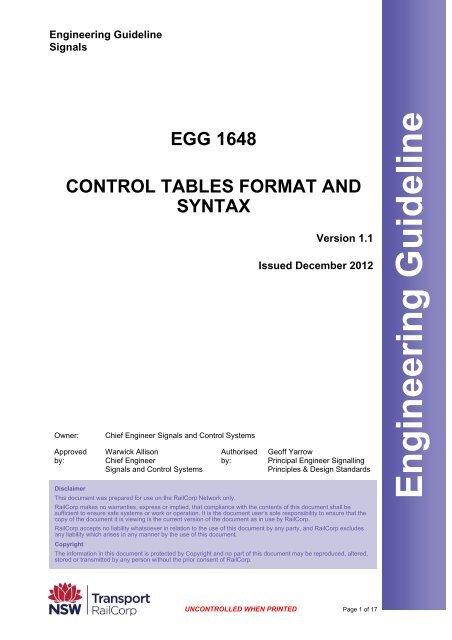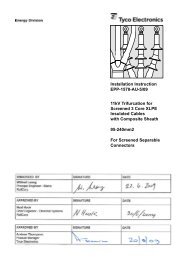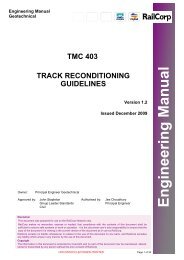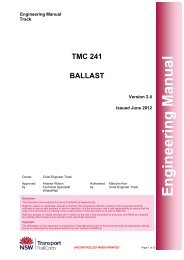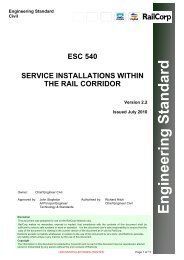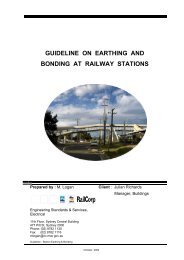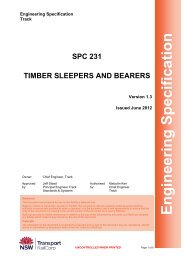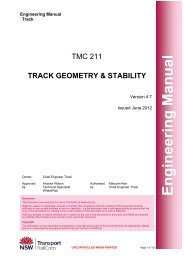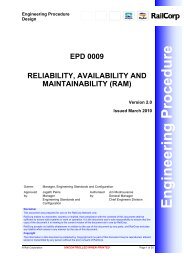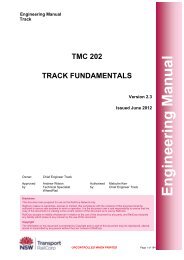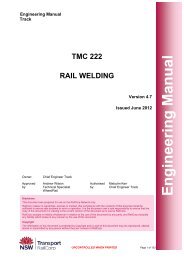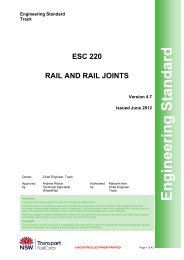Control Tables Format and Syntax - RailCorp Engineering Internet
Control Tables Format and Syntax - RailCorp Engineering Internet
Control Tables Format and Syntax - RailCorp Engineering Internet
Create successful ePaper yourself
Turn your PDF publications into a flip-book with our unique Google optimized e-Paper software.
<strong>Engineering</strong> Guideline<br />
Signals<br />
EGG 1648<br />
CONTROL TABLES FORMAT AND<br />
SYNTAX<br />
Owner: Chief Engineer Signals <strong>and</strong> <strong>Control</strong> Systems<br />
Approved<br />
by:<br />
Warwick Allison<br />
Chief Engineer<br />
Signals <strong>and</strong> <strong>Control</strong> Systems<br />
Authorised<br />
by:<br />
Version 1.1<br />
Issued December 2012<br />
Geoff Yarrow<br />
Principal Engineer Signalling<br />
Principles & Design St<strong>and</strong>ards<br />
Disclaimer<br />
This document was prepared for use on the <strong>RailCorp</strong> Network only.<br />
<strong>RailCorp</strong> makes no warranties, express or implied, that compliance with the contents of this document shall be<br />
sufficient to ensure safe systems or work or operation. It is the document user’s sole responsibility to ensure that the<br />
copy of the document it is viewing is the current version of the document as in use by <strong>RailCorp</strong>.<br />
<strong>RailCorp</strong> accepts no liability whatsoever in relation to the use of this document by any party, <strong>and</strong> <strong>RailCorp</strong> excludes<br />
any liability which arises in any manner by the use of this document.<br />
Copyright<br />
The information in this document is protected by Copyright <strong>and</strong> no part of this document may be reproduced, altered,<br />
stored or transmitted by any person without the prior consent of <strong>RailCorp</strong>.<br />
UNCONTROLLED WHEN PRINTED Page 1 of 17<br />
<strong>Engineering</strong> Guideline
<strong>RailCorp</strong> <strong>Engineering</strong> Guideline — Signals<br />
<strong>Control</strong> <strong>Tables</strong> <strong>Format</strong> <strong>and</strong> <strong>Syntax</strong> EGG 1648<br />
Document control<br />
Version Date Summary of change<br />
1.0 8 Nov. 2012 First Issue<br />
1.1 18 Dec.2012 Updated §7 for showing Override on signal (route) control<br />
table, <strong>and</strong> to clarify requirements for conditional clearing<br />
timers control table.<br />
Summary of changes from previous version<br />
Summary of change Section<br />
NOTE – If the final document is small enough for the ‘Contents’ <strong>and</strong> ‘Document control’<br />
to fit on one page remove the page break between the existing pages 2 <strong>and</strong> 3.<br />
HOWEVER if the ‘Document control’ page carries over to a second page separate<br />
pages must be used for ‘Contents’ <strong>and</strong> ‘Document control’<br />
If there are no changes or they are so minor that they will fit in the above table delete<br />
this table <strong>and</strong> its heading.<br />
© <strong>RailCorp</strong> Page 2 of 17<br />
Issued December 2012 UNCONTROLLED WHEN PRINTED Version 1.1
<strong>RailCorp</strong> <strong>Engineering</strong> Guideline — Signals<br />
<strong>Control</strong> <strong>Tables</strong> <strong>Format</strong> <strong>and</strong> <strong>Syntax</strong> EGG 1648<br />
Contents<br />
1 Introduction .............................................................................................................................4<br />
2 Scope........................................................................................................................................4<br />
2.1 Application.................................................................................................................................4<br />
3 Reference documents.............................................................................................................4<br />
4 Terms <strong>and</strong> definitions.............................................................................................................4<br />
5 <strong>Control</strong> <strong>Tables</strong> <strong>Format</strong>............................................................................................................5<br />
5.1 File <strong>Format</strong> ................................................................................................................................5<br />
5.2 Document Layout ......................................................................................................................5<br />
6 <strong>Control</strong> <strong>Tables</strong> <strong>Syntax</strong> ............................................................................................................6<br />
6.1 Signal Names............................................................................................................................6<br />
6.2 General Notations .....................................................................................................................6<br />
6.3 Logic Notation ...........................................................................................................................6<br />
6.3.1 Track Timers..............................................................................................................8<br />
6.3.2 Conditional Clearing of Signals .................................................................................8<br />
6.4 Aspects......................................................................................................................................9<br />
6.4.1 Higher Aspects ..........................................................................................................9<br />
6.4.2 Lamp Proving...........................................................................................................10<br />
6.4.3 Co-Acting Signal Aspects ........................................................................................10<br />
6.5 Remarks..................................................................................................................................10<br />
7 Rules for specific <strong>Tables</strong>......................................................................................................11<br />
7.1 Routes.....................................................................................................................................11<br />
7.2 Level Crossings, Warning Lights ............................................................................................11<br />
7.3 Timers .....................................................................................................................................11<br />
7.4 Section <strong>Control</strong>........................................................................................................................12<br />
7.5 Trainstops ...............................................................................................................................12<br />
Appendix A Sample <strong>Tables</strong>........................................................................................................13<br />
© <strong>RailCorp</strong> Page 3 of 17<br />
Issued December 2012 UNCONTROLLED WHEN PRINTED Version 1.1
<strong>RailCorp</strong> <strong>Engineering</strong> Guideline — Signals<br />
<strong>Control</strong> <strong>Tables</strong> <strong>Format</strong> <strong>and</strong> <strong>Syntax</strong> EGG 1648<br />
1 Introduction<br />
2 Scope<br />
<strong>Control</strong> <strong>Tables</strong> define safety <strong>and</strong> operational requirements for a signalling arrangement in<br />
a textual manner. They are initially prepared by a competent person who applies<br />
approved signalling st<strong>and</strong>ards, principles, <strong>and</strong> guidelines, to the proposed signalling<br />
layout <strong>and</strong> signalling functional specification. Once complete, they are manually<br />
translated by design engineers into circuit wiring diagrams <strong>and</strong>/or Computer Based<br />
Interlocking data expressions. They may be required for independent design of an<br />
operator control system. They are also used in the validation <strong>and</strong> testing processes.<br />
With the number of different parties involved in preparing <strong>and</strong> using control tables, it is<br />
essential that they are produced to a consistent st<strong>and</strong>ard for format <strong>and</strong> syntax. This will<br />
avoid misinterpretation in the design of wiring diagrams <strong>and</strong> CBI data expressions, <strong>and</strong><br />
may facilitate possible use of computer programs to extract information from the control<br />
tables <strong>and</strong> convert to algorithmic expressions for software-based systems.<br />
2.1 Application<br />
This document is intended for use by all parties, internal or external, preparing, updating,<br />
or otherwise using, control tables for <strong>RailCorp</strong> signalling systems.<br />
3 Reference documents<br />
QSDP 29 St<strong>and</strong>ard Forms<br />
4 Terms <strong>and</strong> definitions<br />
The following definitions apply in this document:<br />
Extensible Markup Language (XML): A computer file format used for storing formatted<br />
data in a plain text file, with the formatting data included amongst the textual content as<br />
'tags' enclosed within delimiting characters (markup) as defined in the open st<strong>and</strong>ard<br />
XML 1.0 Specification. Appropriate software tools display the content formatted<br />
according to the tags, or when editing the document, insert the tags. Being an open<br />
st<strong>and</strong>ard format based on plain text, it is relatively easy to develop tools to automatically<br />
process the data.<br />
© <strong>RailCorp</strong> Page 4 of 17<br />
Issued December 2012 UNCONTROLLED WHEN PRINTED Version 1.1
<strong>RailCorp</strong> <strong>Engineering</strong> Guideline — Signals<br />
<strong>Control</strong> <strong>Tables</strong> <strong>Format</strong> <strong>and</strong> <strong>Syntax</strong> EGG 1648<br />
5 <strong>Control</strong> <strong>Tables</strong> <strong>Format</strong><br />
5.1 File <strong>Format</strong><br />
<strong>Tables</strong> shall be prepared using the templates in QSDP29 St<strong>and</strong>ard Forms. The<br />
templates are xml documents which can be edited in Microsoft Word or compatible<br />
applications.<br />
<strong>Control</strong> tables shall be prepared in Word, to take advantage of the inbuilt change tracking<br />
features. Any h<strong>and</strong>-written modifications during testing must be updated to the electronic<br />
copies before submission for review / verification.<br />
A separate file shall be used for each route, points, etc. This ensures that edits to one<br />
table cannot result in inadvertent changes in another table, <strong>and</strong> assists in tracking edits<br />
either by file modification dates or using document management software (e.g.<br />
SourceSafe).<br />
5.2 Document Layout<br />
The layout <strong>and</strong> naming of fields must not be changed.<br />
When editing tables in Word, fields will automatically ‘grow’ to a new line as the text<br />
reaches the end of the available space. However, for entries such as Route Locking <strong>and</strong><br />
for automatic signals, warning lights, etc, where a row of data encompassing several<br />
columns makes up a single entry, each entry must be in a new table row. Macro buttons<br />
are provided on the relevant sheets to insert new rows at the bottom of the appropriate<br />
section.<br />
The table will also automatically flow to a new page as necessary. The templates are<br />
formatted to repeat header rows at the top of each page, which will be the fields<br />
identifying the route, points, etc, for which the control table applies.<br />
© <strong>RailCorp</strong> Page 5 of 17<br />
Issued December 2012 UNCONTROLLED WHEN PRINTED Version 1.1
<strong>RailCorp</strong> <strong>Engineering</strong> Guideline — Signals<br />
<strong>Control</strong> <strong>Tables</strong> <strong>Format</strong> <strong>and</strong> <strong>Syntax</strong> EGG 1648<br />
6 <strong>Control</strong> <strong>Tables</strong> <strong>Syntax</strong><br />
6.1 Signal Names<br />
On control tables, the full signal name/identifier will typically be given only in the ‘Signal’<br />
field at the top of the table. Thereafter, any alphabetic prefix <strong>and</strong> suffix shall be not<br />
included unless it is necessary to uniquely identify the signal, such as distance-numbered<br />
signals at the same distance in multiple track or bi-directional areas, or to denote a signal<br />
at an adjacent interlocking.<br />
6.2 General Notations<br />
The percent sign ‘%’ shown after a track circuit name is used to denote the named track<br />
circuit is occupied, e.g. 6AT%.<br />
Double quotations marks ( ” ) after a numerical value denote a time in seconds, e.g. 120”.<br />
Lower-case ‘w’ means ‘with’.<br />
The ‘at’ symbol ‘@’ means points or releases are locked <strong>and</strong> detected only.<br />
Points are denoted Normal or Reverse using ‘N’ or ‘R’ respectively after the points<br />
number, but this is not required where the context makes the intent clear – for example,<br />
in the ‘Normal’ field under ‘Sets, Locks <strong>and</strong> Detects Points’ of a route control table, the ‘N’<br />
or ‘R’ is only required with a second set of points which is a condition for calling the first<br />
set.<br />
Routes are denoted Reverse by using ‘R’ after the route. A route without ‘R’ is generally<br />
understood to be Normal, except when context makes clear that routes are reverse – for<br />
example, in the ‘Set <strong>and</strong> Locked by Routes’ field of a points control table.<br />
Separate terms shall be delineated by at least one space (or new line if necessary); the<br />
use of multiple spaces is permitted to aid readability.<br />
6.3 Logic Notation<br />
<strong>Control</strong> tables are written in a form similar to Boolean expression. Boolean expression<br />
already has defined syntax, <strong>and</strong> in general the language of control tables should not<br />
contradict general Boolean rules. For example, AND logic takes precedence over OR<br />
logic.<br />
AND Logic<br />
A full stop shall be used to denote that terms are to be combined by logical ‘<strong>and</strong>’ (i.e.<br />
series contacts). Commas shall not be used. The full stop is consistent with general<br />
notation using a dot to denote ‘<strong>and</strong>’ when writing logic expressions. The general rule for<br />
separating different terms with a space ensures there is no confusion when writing<br />
distance-based names of signals or track circuits with a decimal point.<br />
e.g.<br />
21(S)B. 26(M)A. 26(S)A. 34(M)<br />
43AT. 43BT. 19.3AT. 19.3BT<br />
Where the list continues over multiple lines, the full stop should be included at the end of<br />
each line except the last.<br />
© <strong>RailCorp</strong> Page 6 of 17<br />
Issued December 2012 UNCONTROLLED WHEN PRINTED Version 1.1
<strong>RailCorp</strong> <strong>Engineering</strong> Guideline — Signals<br />
<strong>Control</strong> <strong>Tables</strong> <strong>Format</strong> <strong>and</strong> <strong>Syntax</strong> EGG 1648<br />
OR Logic<br />
The word ‘or’ (lower case) shall be used to denote that terms are to be combined by<br />
logical ‘or’ (i.e. parallel circuit paths), e.g.<br />
[103N or 104R]<br />
[22.7AT% or 22.1CT%]<br />
Negated Logic<br />
Most statements relating to track circuits require the track circuit unoccupied; an occupied<br />
track circuit is denoted with % as described earlier.<br />
Routes <strong>and</strong> points are either Normal or Reverse, so NOT logic is rarely required with<br />
these. Where negated logic is required, the word ‘not’ (lower case) shall be used, with a<br />
space either side, e.g.<br />
[212N w 211R <strong>and</strong> not free]<br />
Conditional Logic<br />
In the general population, conditional logic would take the form ‘if X then Y’. On control<br />
tables, it is expressed in the form of ‘Y w X’, where ‘w’ means ‘with’ (or ‘when’). For<br />
example,<br />
[49(M)B w 203R]<br />
[31YT w 202R]<br />
Conditional logic is usually implemented as ‘X or (not Y)’, so should be treated the same<br />
as an OR statement in terms of precedence of evaluation.<br />
Converse Locking <strong>and</strong> Preferences<br />
Where locking alternatives exist <strong>and</strong> one must be chosen, multiple converse statements<br />
are written. In the example of a route requiring either 49(M)B route normal or 203 points<br />
normal, the statements are written in the form<br />
[49(M)B w 203R]<br />
[203N w 49(M)BR]<br />
In the above case, if route 49(M)B is not normal, the interlocking does not have the option<br />
to normalise the route, so the points must be called. However, where locking alternatives<br />
include multiple sets of points, an order of preference must be determined, <strong>and</strong> is<br />
denoted by a number after the statement:<br />
[204N w 207R]1<br />
[207N w 204R]2<br />
In some circumstances, allowing the interlocking to automatically select one of the<br />
options is undesirable, so it will be ‘locked <strong>and</strong> detected only’:<br />
[206N w 204N]<br />
[204R w 206R]@<br />
© <strong>RailCorp</strong> Page 7 of 17<br />
Issued December 2012 UNCONTROLLED WHEN PRINTED Version 1.1
<strong>RailCorp</strong> <strong>Engineering</strong> Guideline — Signals<br />
<strong>Control</strong> <strong>Tables</strong> <strong>Format</strong> <strong>and</strong> <strong>Syntax</strong> EGG 1648<br />
Brackets <strong>and</strong> Parentheses<br />
Brackets [ ], parentheses ( ( ), <strong>and</strong> braces { }, may be used interchangeably whenever<br />
‘brackets’ are referenced in this guideline. Brackets [ ] should be used as first preference,<br />
preference,<br />
to to reduce visual confusion with the parentheses used for (M) or (S) route notation. When<br />
nesting multiple levels of brackets (i.e. brackets within brackets), different shaped<br />
brackets shall be used used where possible to avoid having the same shaped brackets<br />
adjacent, e.g. [(xyz). {abc}] .<br />
In general Boolean expression, brackets are are only only required when OR OR logic must take<br />
precedence precedence over over AND logic. For example, on the following following track layouts the tracks tracks<br />
required clear for the overlap are:<br />
31AT. [31BT. 31CT w 202N]. [31XT. 31YT w 202R]<br />
It is preferable however to use additional brackets to avoid any ambiguity.<br />
31AT. [(31BT. 31CT) w 202N]. [(31XT. 31YT) w 202R]<br />
Where possible, nesting of more than three sets of brackets should be avoided, by<br />
breaking complex statements down, even if that results in repetition.<br />
[({39BT w 107N}. {40AT w 107R}. {40BT w 107R. 108R}) or 23BT JR]<br />
6.3.1 Track Timers<br />
31AT 31BT<br />
202<br />
31CT<br />
31XT 31YT<br />
Track timers used either for for speed speed checking (conditional clearing of signals or trainstops) trainstops)<br />
or for release of route route holding are calculated based on a a required speed speed <strong>and</strong> <strong>and</strong> the length of<br />
the timing track(s). A A specific table is is provided for calculating these these timers. To minimise<br />
potential for errors, errors, any function which uses one of these timers timers should refer refer to the the timing<br />
function, not the duration of the timer.<br />
After using route Released by<br />
[{44(M)B or 44(S)B} w 107R] 44BT JR(P)<br />
6.3.2 Conditional Clearing of Signals<br />
Conditional clearing shall be written as an ‘or’ statement. For clarity, the conditional<br />
portion of the statement should be written on a new line.<br />
14.5AT. 14.5BT. 14.9AT.<br />
[(14.9BT. 14.9CT) or 13.7BT JR]<br />
© <strong>RailCorp</strong> Page 8 of 17<br />
Issued December 2012 UNCONTROLLED WHEN PRINTED Version 1.1
<strong>RailCorp</strong> <strong>Engineering</strong> Guideline — Signals<br />
<strong>Control</strong> <strong>Tables</strong> <strong>Format</strong> <strong>and</strong> <strong>Syntax</strong> EGG 1648<br />
6.4 Aspects<br />
Aspects shall be described using the following notation<br />
R<br />
Y<br />
PY<br />
G<br />
LH BOL<br />
RH BOL<br />
LH PBOL<br />
RH PBOL<br />
LH TOR<br />
RH TOR<br />
Red<br />
Yellow<br />
Pulsating Yellow<br />
Green<br />
Left-h<strong>and</strong> ‘B<strong>and</strong> of Lights’<br />
Right-h<strong>and</strong> ‘B<strong>and</strong> of Lights’<br />
Left-h<strong>and</strong> Pulsating ‘B<strong>and</strong> of Lights’<br />
Right-h<strong>and</strong> Pulsating ‘B<strong>and</strong> of Lights’<br />
Left-h<strong>and</strong> Turnout Repeater<br />
Right-h<strong>and</strong> Turnout Repeater<br />
LS Low Speed<br />
Shunt Yellow shunt (either subsidiary aspect or ground shunt)<br />
TS<br />
Trainstop<br />
ITS<br />
Intermediate Trainstop<br />
For double-light signal indications, the indication shall be written in the form<br />
top head / bottom head<br />
e.g. G/R for ‘green over red’.<br />
Where a route indicator is used, the character(s) displayed by the route indicator are<br />
appended to the indication as follows:<br />
Y/R + ‘DE’<br />
RH BOL + ‘R’<br />
Shunt + ‘US’<br />
A Turnout Repeater is denoted:<br />
G/Y + RH TOR<br />
Where a signal can simultaneously display both a main line route indicator <strong>and</strong> a turnout<br />
repeater, the route indicator (as the immediate information) shall be appended first, then<br />
the turnout repeater:<br />
G/PY + ‘M’ + LH TOR<br />
For subsidiary indications, <strong>and</strong> for a turnout indication on a single-light signal, the red<br />
indication of the main signal is not to be stated.<br />
LS not R/R/LS<br />
LH BOL not R/LH BOL<br />
6.4.1 Higher Aspects<br />
Higher aspects shall generally be written using the notation as already described –<br />
indication <strong>and</strong> conditions:<br />
[G/Y w 60 G/R . 63TS R]. [G/G w 60 G/Y . 52 G/Y . 63TS R]<br />
© <strong>RailCorp</strong> Page 9 of 17<br />
Issued December 2012 UNCONTROLLED WHEN PRINTED Version 1.1
<strong>RailCorp</strong> <strong>Engineering</strong> Guideline — Signals<br />
<strong>Control</strong> <strong>Tables</strong> <strong>Format</strong> <strong>and</strong> <strong>Syntax</strong> EGG 1648<br />
6.4.2 Lamp Proving<br />
Lamp proving for single-light signals <strong>and</strong> for turnout repeaters shall not be detailed on<br />
control tables.<br />
6.4.3 Co-Acting Signal Aspects<br />
Where a co-acting signal is provided, indications for the co-acting shall be detailed in the<br />
‘Higher Aspects’ field of the table, on a separate line after the higher aspects of the<br />
parent signal. The keywords ‘Co-acting’ <strong>and</strong> ‘parent’ must be used.<br />
If the co-acting signal displays exactly the same indications as the main signal, it shall be<br />
noted as:<br />
[Co-acting as per parent]<br />
Where the co-acting signal displays different indications (typically where a single-light<br />
‘dwarf’ signal is used to co-act for a double-light signal), each indication shall be listed<br />
with the conditions of the parent signal, e.g.<br />
6.5 Remarks<br />
[Co-acting Y + ‘L’ w parent G/R or G/Y]. [Co-acting G w parent G/G]<br />
For readability, use of upper- <strong>and</strong> lower-case should be as per the examples.<br />
Remarks fall into two broad categories:<br />
a) details which are not covered by any of the st<strong>and</strong>ard fields of the tables, <strong>and</strong><br />
b) variations to st<strong>and</strong>ard implementation.<br />
Where the remarks are detailing variations, they will usually relate to a specific entry in<br />
the table. In such cases, a crosshatch mark (#) shall be added after the relevant<br />
statement in the control table to reference the remark. Where multiple statements refer to<br />
different remarks, each shall be numbered #1, #2, etc. Multiple statements can reference<br />
a single remark where appropriate.<br />
To support possible future automated processing of control tables, common remarks<br />
should use consistent wording as follows:<br />
[Guard’s Indicator]<br />
[Route not to set if ]<br />
[Signal not to clear until ]<br />
[Must detect before setting with ]<br />
[Flashing green repeater]<br />
[Locking required at RUR level]<br />
[No automatic normalising] [No lever stick]<br />
© <strong>RailCorp</strong> Page 10 of 17<br />
Issued December 2012 UNCONTROLLED WHEN PRINTED Version 1.1
<strong>RailCorp</strong> <strong>Engineering</strong> Guideline — Signals<br />
<strong>Control</strong> <strong>Tables</strong> <strong>Format</strong> <strong>and</strong> <strong>Syntax</strong> EGG 1648<br />
7 Rules for specific <strong>Tables</strong><br />
7.1 Routes<br />
The Auto-reclearing <strong>and</strong> Quick Release (for Approach Locking) fields require only ‘Yes’<br />
or ‘No’. In particular, there shall be no reference specific track circuits, TZR, or POJR, for<br />
release of approach locking. Implementation shall be according to the st<strong>and</strong>ards in force<br />
at the time of design for new interlockings, or consistent with existing arrangements for<br />
modification of existing interlockings.<br />
The Override field must start with 'Sets route' or 'Cancels route', followed by any<br />
conditions, or 'Not applicable', e.g.:<br />
Cancels route with [list of tracks required unoccupied] or override route normalising<br />
timer<br />
Through running<br />
Sets route <strong>and</strong> auto-reclearing<br />
Automatic turn-back<br />
Sets route with 15BT% 60"<br />
Automatic Normalising <strong>and</strong> Lever Stick are not shown on the table. It is assumed that<br />
Automatic Normalising is provided, <strong>and</strong> the first track after the signal is used for the Lever<br />
Stick. If a route is required to not automatically normalise <strong>and</strong> / or a different lever stick<br />
arrangement is required (including no lever stick), this shall be recorded in the Remarks<br />
field.<br />
7.2 Level Crossings, Warning Lights<br />
7.3 Timers<br />
These tables are only used to define the track circuit control for the warning equipment.<br />
Any interlocking with signals – delay clearing of signals to achieve minimum warning<br />
time, or continuation of warning until approach locking is released – is to be described on<br />
the appropriate signal control tables.<br />
Separate sheets are provided for conditional clearing timers (may include timers for<br />
intermediate trainstops) <strong>and</strong> route locking release timers.<br />
Word does not recalculate formulas after an input value is changed. A macro button is<br />
provided to recalculate timers. Enter the input parameters for each timer, then press the<br />
button to recalculate. The macro will determine a CALCULATED time for the proving<br />
speed <strong>and</strong> timing track length, to provide a SET TIME for practical use. As per design<br />
principles, the macro will round release timers up to the next multiple of 15 seconds.<br />
Conditional clearing timers will be rounded down by between 0.7 <strong>and</strong> 1.7 seconds to<br />
allow for trainstop drive time. After the theoretical time is calculated, the designer should<br />
review the calculated ALLOWANCE <strong>and</strong> SET TIME, <strong>and</strong> may make adjustments if<br />
required. Timers should always be rounded to whole seconds.<br />
Note that if any parameters are changed, or new timers added, it will be necessary to<br />
press the macro button to recalculate the timers. This will recalculate all timers in the file.<br />
Where the CALCULATED TIME of an existing entry changes, the SET TIME will be<br />
© <strong>RailCorp</strong> Page 11 of 17<br />
Issued December 2012 UNCONTROLLED WHEN PRINTED Version 1.1
<strong>RailCorp</strong> <strong>Engineering</strong> Guideline — Signals<br />
<strong>Control</strong> <strong>Tables</strong> <strong>Format</strong> <strong>and</strong> <strong>Syntax</strong> EGG 1648<br />
automatically deleted. Where the CALCULATED TIME does not change, the SET TIME<br />
will remain.<br />
7.4 Section <strong>Control</strong><br />
The Section <strong>Control</strong> control table is largely redundant. Requirements for single line <strong>and</strong><br />
bi-directional controls are more appropriately described on the control tables for the<br />
starting signals <strong>and</strong>, where applicable, in-section automatic signals.<br />
7.5 Trainstops<br />
The Trainstop control table is largely redundant. Requirements for intermediate<br />
trainstops shall generally be included on control tables for signals.<br />
© <strong>RailCorp</strong> Page 12 of 17<br />
Issued December 2012 UNCONTROLLED WHEN PRINTED Version 1.1
<strong>RailCorp</strong> <strong>Engineering</strong> Guideline — Signals<br />
<strong>Control</strong> <strong>Tables</strong> <strong>Format</strong> <strong>and</strong> <strong>Syntax</strong> EGG 1648<br />
Appendix A Sample <strong>Tables</strong><br />
The following examples are not intended to reflect any specific track layout, but only to<br />
demonstrate the use of syntax, including samples of converse locking statements.<br />
© <strong>RailCorp</strong> Page 13 of 17<br />
Issued December 2012 UNCONTROLLED WHEN PRINTED Version 1.1
<strong>RailCorp</strong> <strong>Engineering</strong> Guideline — Signals<br />
<strong>Control</strong> <strong>Tables</strong> <strong>Format</strong> <strong>and</strong> <strong>Syntax</strong> EGG 1648<br />
Route <strong>Control</strong> Table<br />
INTERLOCKING South Gotham SIGNAL SG27 ROUTE 27(M)B<br />
Commence 27(M) Set by -<br />
Finish 39(M) Also sets 33(S)B<br />
Auto-reclearing Yes First Aspect G/R<br />
Override Cancels route with [list of approach tracks] clear or override route normalising timer<br />
REQUIRES ROUTES 27(S)B. 30(M). 30(S). 38(S). 40(M)B. 40(S)B. 42(S)B.<br />
NORMAL<br />
[(44(M)B. 44(S)B) W 107R]<br />
SETS, LOCKS AND DETECTS POINTS<br />
104. 105. 106.<br />
(@ = Locked <strong>and</strong> Detected Only) (% = Occupied)<br />
Normal<br />
Reverse<br />
[107 w 44(M)BR or 44(S)BR]<br />
[114 w 115R]1. [115 w 114R]2<br />
[112 w 111N]<br />
[111 w 112R]@<br />
SET AND INDIRECTLY LOCKED<br />
Normal [112 w 25(M)R. 62(M)R]<br />
Reverse<br />
SET POINTS IN [105N. 106N then 104N w 23(M)R]<br />
SEQUENCE<br />
Trainstops 27, 30<br />
[30 held by (27AT% or 27BT%) W 104N]<br />
ROUTE LOCKING<br />
Locked by tracks After using route Released by<br />
[44AT w 111N]. 44BT [{44(M)B or 44(S)B} w 107R] 44BT JR(P)<br />
39AT. 27DT 38(S) #1 -<br />
[{40AT. 40BT} w 107R]. 39AT. 27DT 40(M)B or 40(S)B or 42(S)B #1 -<br />
REQUIRES TRACKS 27AT. 27BT. 27CT. 27DT. 39AT. [40BT w 107R].<br />
CLEAR<br />
[({39BT w 107N}. {40AT w 107R}. {40BT w 107R. 108R}) or 23BT JR]<br />
ASPECTS<br />
APPROACH LOCKING<br />
[G/Y w 39 G/R. 34TS R]. [G/G w {39 G/Y or G/G}. 34TS R]<br />
[Co-acting Y + ‘M’ w parent {G/R or G/Y}]. [Co-acting G w parent G/G]<br />
Locked by tracks 23BT. 23AT. [{17BT. 17AT} w 23(M)R]<br />
Release timer 120” Quick Release No<br />
REMARKS [Guards indicator]<br />
#1: [Locking required at RUR level]<br />
DESIGNER JOB No. S12345 VERSION DATE 01 Apr 2012<br />
© <strong>RailCorp</strong> Page 14 of 17<br />
Issued December 2012 UNCONTROLLED WHEN PRINTED Version 1.1
<strong>RailCorp</strong> <strong>Engineering</strong> Guideline — Signals<br />
<strong>Control</strong> <strong>Tables</strong> <strong>Format</strong> <strong>and</strong> <strong>Syntax</strong> EGG 1648<br />
Points <strong>Control</strong> Table<br />
INTERLOCKING South Gotham POINT 107<br />
TRACK LOCKING 39AT. 40BT<br />
SET AND LOCKED BY ROUTES (@ = Locked <strong>and</strong> Detected Only) (% = Occupied)<br />
Normal<br />
38(S). 39(M)A. 39(S)A. 40(M)A. 40(S)A. 41(M)A. 41(S)A. 41(S)B. 42(S)A. 46(S)A.<br />
[27(M)B w {44(M)BR or 44(S)BR]. [27(S)B w 44(M)BR]. [33(S)A w 44(M)BR].<br />
[44(M)B w {27(M)BR or 27(S)BR or 33(S)AR}]. [44(S)B w 27(M)BR]<br />
Reverse<br />
39(S)B. 39(S)C. 40(M)B. 40(S)B. 42(S)B<br />
SET ONLY BY ROUTES<br />
Normal 32(M)B w 19(M).56(M)<br />
Reverse<br />
SET AND LOCKED BY RELEASES SET ONLY BY RELEASES<br />
Normal<br />
Reverse<br />
ROUTE LOCKING<br />
Locked NORMAL by tracks After using route Released by<br />
[(27AT. 27BT) w 104N]. 27CT. 27DT [27(M)B w {44(M)BR or 44(S)BR}] 27DT% JR(P)<br />
[(27AT. 27BT) w 104N]. 27CT. 27DT [27(S)B w 44(M)BR] 27DT% JR(P)<br />
[44AT w 111N]. 44BT [44(M)B w {27(M)BR or 27(S)BR or 33(S)AR}] 44BT% JR(P)<br />
[44AT w 111N]. 44BT [44(S)B w 27(M)BR] 44BT% JR(P)<br />
40AT 40(M)A or 40(S)A or 42(S)A 39BT% JR(P)<br />
[{(47AT w 112N). 45BT} w 109 N]. 45AT. 39BT 46(S)A -<br />
Locked REVERSE by tracks After using route Released by<br />
40AT 40(M)B or 40(S)B or 42(S)B -<br />
OVERLAP MAINTENANCE<br />
Held NORMAL by tracks After using route Released by<br />
27DT 44(M)B 44BT% JR(P)<br />
40AT. [TBAT w 108R] 27(M)B 27DT% JR(P)<br />
Held REVERSE by tracks After using route Released by<br />
40CT 44(M)B 44BT% JR(P)<br />
39BT 27(M)B 27DT% JR(P)<br />
REMARKS<br />
DESIGNER JOB No. S12345<br />
VERSION DATE 01 Apr 2012<br />
© <strong>RailCorp</strong> Page 15 of 17<br />
Issued December 2012 UNCONTROLLED WHEN PRINTED Version 1.1
<strong>RailCorp</strong> <strong>Engineering</strong> Guideline — Signals<br />
<strong>Control</strong> <strong>Tables</strong> <strong>Format</strong> <strong>and</strong> <strong>Syntax</strong> EGG 1648<br />
Automatic Signals control table<br />
SECTION South Gotham - Metropolis<br />
SIGNAL LINE / km REQUIRES TRACKS CLEAR<br />
M14.9 Down Main<br />
14.883<br />
L14.9 Down Local<br />
14.885<br />
M14.9AT. M14.9BT. M15.7AT.<br />
[(M15.7BT. M16.3AT) or 447CT JR]<br />
L14.9AT. L14.9BT. L15.7AT.<br />
[L15.7BT or 451CT JR]<br />
ASPECTS<br />
First Higher<br />
G/R G/Y w M15.7 G/R<br />
G/PY w M15.7 G/Y<br />
G/G w M15.7 G/G<br />
G/R G/Y w L15.7 G/R<br />
G/G w L15.7 G/Y or G/G<br />
TRAINSTOP REMARKS<br />
DESIGNER JOB No. S12345 VERSION DATE 01 Apr 2012<br />
Conditional Clearing Timers control table<br />
SECTION / INTERLOCKING South Gotham - Metropolis<br />
SIGNAL APPROACH CONDITIONAL OVERLAP TIMING APPROACH TIMER (s)<br />
or TRACK(S) LENGTH<br />
TRACK(S) LENGTH Ave. BRAKE SPEED CALCULATED ALLOWANCE SET<br />
TRAINSTOP<br />
(m)<br />
(m) GRADE CURVE (km/h)<br />
TIME<br />
M14.9 447CT 300 M15.7AT 220 -150 GE52A 43 25.1 1.1 24<br />
L14.9 451BT 332 L15.7AT 220 -150 GE52A 43 27.8 0.8 27<br />
DESIGNER JOB No. S12345 VERSION DATE 01 Apr 2012<br />
Release Timers control table<br />
SECTION / INTERLOCKING South Gotham<br />
TIMER PURPOSE TIMING DISTANCE (m) TARGET SPEED (km/h) CALCULATED TIMER (s) SET TIME (s)<br />
34BT JRP Route Release 187 15 44.9 45<br />
36BT JRP Route Release 188 15 45.1 60<br />
68BT JRP Route Release 235 25 33.8 45<br />
DESIGNER JOB No. S12345 VERSION DATE 01 Apr 2012<br />
© <strong>RailCorp</strong> Page 16 of 17<br />
Issued December 2012 UNCONTROLLED WHEN PRINTED Version 1.1<br />
M14.9<br />
L14.9
<strong>RailCorp</strong> <strong>Engineering</strong> Guideline — Signals<br />
<strong>Control</strong> <strong>Tables</strong> <strong>Format</strong> <strong>and</strong> <strong>Syntax</strong> EGG 1648<br />
Warning Light control table<br />
SECTION / INTERLOCKING South Gotham - Metropolis<br />
WARNING<br />
LIGHT<br />
LINE / km UP APPROACH LOCAL TRACK DOWN APPROACH REMARKS<br />
9.554 Down N/A 5.33CT 4.87CT. 5.33AT. 5.33BT Average speed 55km/h<br />
9.554 Up 6.44AT. 6.24AT. 6.24BT 5.92AT N/A<br />
DESIGNER JOB No. S12345 VERSION DATE 01 Apr 2012<br />
Level Crossing control table<br />
SECTION / INTERLOCKING South Gotham - Metropolis<br />
LEVEL CROSSING /<br />
UP APPROACH CROSSING<br />
LOCATION<br />
TRACK<br />
Lethbridge-Stewart Lane UX1T. UX2T. UXT<br />
49.455km<br />
DXT<br />
DOWN APPROACH REMARKS<br />
DX1T. DX2T.<br />
DESIGNER JOB No. S12345 VERSION DATE 01 Apr 2012<br />
© <strong>RailCorp</strong> Page 17 of 17<br />
Issued December 2012 UNCONTROLLED WHEN PRINTED Version 1.1


